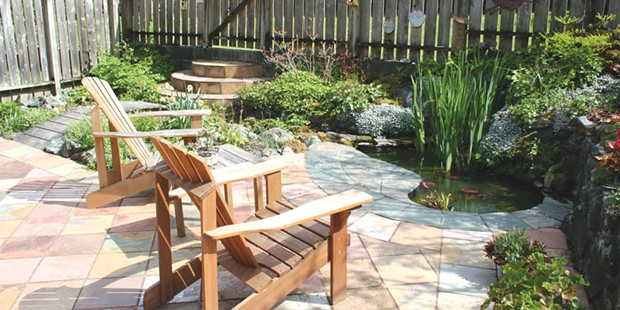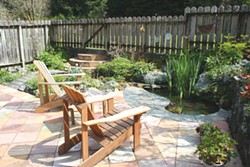[
{
"name": "Top Stories Video Pair",
"insertPoint": "7",
"component": "17087298",
"parentWrapperClass": "fdn-ads-inline-content-block",
"requiredCountToDisplay": "1"
}
]
Our regional plants offer so many ways to deepen our relationship with the environment around us. Not only do they attract birds and native insects (which form the base of our food chain and help birds feed their young — and are charming in their own right), they highlight the unique beauty only found here in Humboldt. There's an unfortunate perception that native plant gardens have a messy look, but just because you are using natives doesn't mean your landscape design should emulate the wildness of nature. Here's how to design them successfully.
Create an orderly frame. I'm currently reading Planting in a Post-Wild World by Thomas Rainer and Claudia West, and they bring up the concept of an "orderly frame." Even chaotic plantings, with grasses and wildflowers tangling together, look refined and intentional when framed by pathways and patios that have a generous size, strong shape and are made of finished-looking materials such as interlocking pavers, stamped concrete or stone. By contrast, unevenly edged pathways covered in straw will make any planting look like it's having a bad hair day. If more permanent materials are outside of your budget, micro fir bark and decomposed granite can be set in a geometric or broadly curving shape to harmonize with the architecture of your home and give plantings a clean look.
Keep the edges crisp. On a similar note, keep the edges scrupulously neat in any areas where your planting beds are bordered by lawn or loose materials such as bark or gravel. As your eyes float across the landscape, the edges make the biggest impression as to whether something is well-kept or out of control. Use either a semi-permanent edging such as brick, bender board, concrete curbing or rocks; a low hedge (either clipped or left natural); or plan to use a string trimmer or pulaski twice a year to define the line of the border. This is less important if you are landscaping with native shrubs, grasses and perennials in a way that already looks well-organized, but becomes more so when you experiment with reseeding annual and biennial wildflowers. Consider how the English wrap a neat hedge of boxwood around an exuberant floral planting and you'll get the idea.
Use a broad brushstroke. Many gardeners passionate about wildlife and native plants start out by trying to replicate the randomized design of nature, tucking a wide variety of single specimen plants throughout the garden. But going from the clean lines and large size of your home straight to a wild space that looks untouched by a human hand feels both out of scale (wrong size) and out of place (wrong feeling). The solution is to cluster plants in broad swaths so each of your plant selections appears as a larger element. A meandering drift of native grasses or perennials can emulate a natural shape like a streambed, yet the bold design still feels appropriate next to the man-made look of your home. While this approach means you have to consider your plant choices that much more carefully since there are far fewer of them, it will give your composition a huge visual impact.
Choose a simple color palette. Plant lovers may find the whole "planting in masses" advice a little hard to swallow, given how many exciting plants there are to experiment with. If you want to use a wider variety of species and still have it look well-designed, one secret to doing so is to choose a limited color palette. By emphasizing a simple array of, say, four colors, you can attain a feeling of continuity throughout the landscape while still enjoying frequent shopping trips to the nursery. When choosing which colors to go with, think about what colors you decorate with indoors. By echoing some of those themes, the view outside your windows will feel like an outdoor extension of your home.
Get to know local wildlife. By learning the names of the specific birds and insects that frequent our local plants, you can better target your plant selections to encourage wildlife to visit. California is a big place, so just planting things native to California may miss the mark when it comes to feeding and supporting the bugs and birds found here in Humboldt. Local author and insect enthusiast Peter Haggard recommends Ceanothus, Twinberry (Lonicera), California wax myrtle (Myrica), native currants and gooseberries (Ribes), and wild buckwheat (Eriogonum) as powerhouse plants for coastal Northern California wildlife. Check out his book Insects of the Pacific Northwest for identifying some of the cool beasties visiting your garden, and Russell Link's book Landscaping for Wildlife in the Pacific Northwest for photos of Northwest birds as well as specific information about which birds are attracted by which plants.
Experiment with pruning natives. While each species of shrub and tree has its own natural habit, native plants can be pruned and shaped just like you would any other, so if you are attracted to a specific type of pruning or landscaping, native plants can be trained to fit your aesthetic. Play with Japanese cloud pruning, remove the lowest branches from a native shrub to make it into a small multi-stemmed tree, or use stakes and ties to shape a supple stem into an interesting spiral. You can retain the regional beauty found in native plants as well as many of the wildlife benefits while still having fun pruning with artistry.
While I love to garden with purely ornamental plants as much as the next person, Humboldt County is the home of such exquisitely beautiful plant life that it's a shame to ignore it in our landscaping. By incorporating some of our region's native plants, we not only attract the local wildlife that has evolved to interact with it, we highlight the special beauty that is only found here, and increase our connection to the world outside the backyard fence. Learn more about native plants at the website of the North Coast Chapter of the California Native Plant Society, www.northcoastcnps.org, where you'll find plant suggestions as well as dates of upcoming lectures and garden walks.
For a detailed monthly to-do list, visit www.northcoastjournal.com/GardenTodo.
Genevieve Schmidt owns a fine landscape maintenance company in Arcata. Visit her on the web at www.GenevieveSchmidtDesign.com.
more from the author
-
Gardening Grab Bag
What's new and cool in the gardening world
- Jun 2, 2016
-
Tackling Weeds Organically
- May 5, 2016
-
The Illusion of Water in the Low-Water Garden
- Apr 7, 2016
- More »

































